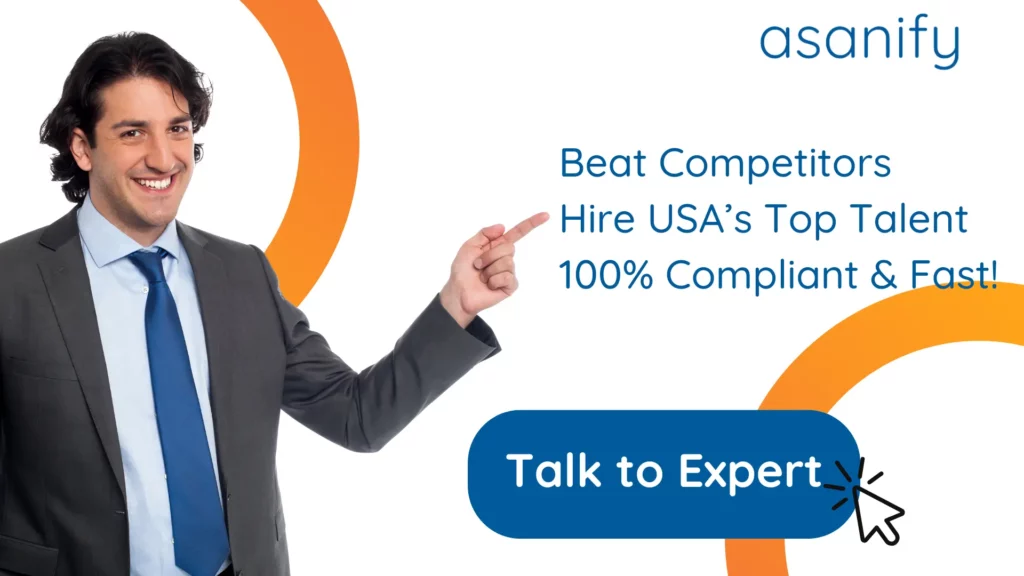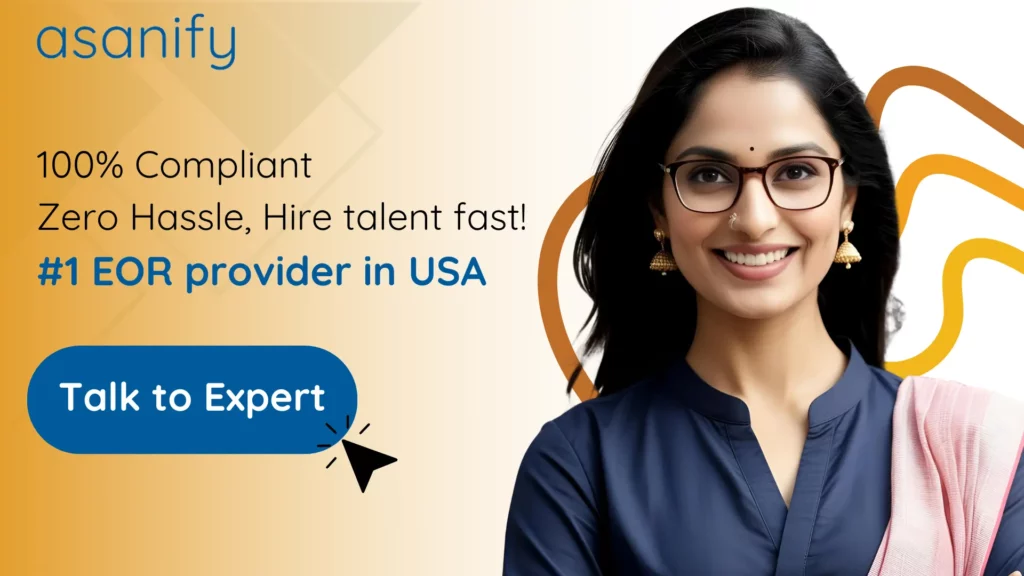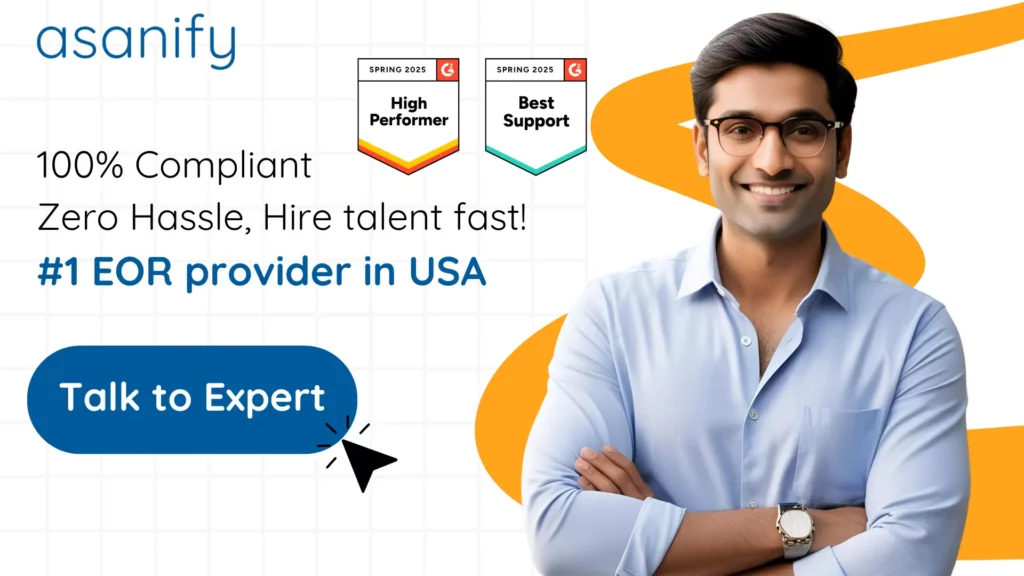The United States is one of the most attractive destinations for businesses and professionals worldwide, offering a massive consumer market, global influence, and diverse industry opportunities. However, before hiring in the USA, employers must navigate the country’s complex immigration and work authorization process. Securing the correct work permit and visa in the USA is critical to staying compliant with U.S. immigration laws and ensuring a smooth onboarding process for non-U.S. employees.
Table of Contents
- Overview of the USA’s Work Permit and Visa System
- Understanding Requirements and Eligibility
- Who Needs a Work Visa in the USA
- Key Conditions for Obtaining a U.S. Work Visa
- Employer and Employee Eligibility
- Types of Work Visas and Permits in the USA
- Comparing Work Visa Types
- Application Process for Employers
- Required Documents
- Processing Timelines
- Employer Responsibilities and Compliance
- Legal Obligations
- Consequences of Non-Compliance
- Maintaining Ongoing Compliance
- Tips for a Smooth Application Process
- How an Employer of Record Can Help
- How Asanify Can Help
- FAQs
Overview of the USA’s Work Permit and Visa System
The U.S. has a detailed immigration framework that varies based on nationality, skill level, and the nature of employment. While U.S. citizens, permanent residents (Green Card holders), and certain other categories can work without additional permits, most foreign nationals require a specific visa or work authorization before they can legally work in the country. For employers planning to register a business in the USA, understanding these work authorization rules is essential to hiring and onboarding foreign talent compliantly.
- U.S. citizens and permanent residents – No work permit required.
- Foreign nationals – Must obtain an appropriate employment visa or work authorization.
- Employer-sponsored process – Most work visas require employer sponsorship before the employee can apply.
- Multiple agencies involved – U.S. Citizenship and Immigration Services (USCIS), the Department of Labor (DOL), and the Department of State (DOS) may all be part of the process.
- Two-step system – First, employer petition approval; second, visa issuance and entry clearance.

Understanding Requirements and Eligibility
Before applying, both employers and employees should clearly understand the U.S. work authorization framework. The right visa type depends on the worker’s qualifications, job category, and intended duration of stay.
- The U.S. distinguishes between non-immigrant work visas (temporary employment) and immigrant visas (leading to permanent residency).
- Some visa categories are subject to annual quotas or lotteries, such as the H-1B program.
- Work visa eligibility often includes specific wage requirements to protect the local labor market.
- Certain roles require Department of Labor certification before visa applications can proceed.
- Visa rules may restrict job duties, location, or employer changes once approved.
- Dependents of visa holders may have limited or no work rights unless they obtain separate authorization.
Who Needs a Work Visa in the USA
Any non-U.S. citizen who is not a permanent resident and wishes to work in the United States generally requires a valid work visa or employment authorization. This applies to short-term, seasonal, and long-term employment.
- Green Card holders can work without restrictions.
- Unauthorized work can lead to visa loss or penalties.
- Even unpaid roles may need authorization.
- Most visas are tied to a specific employer.
- Some dependents need an EAD to work.
Key Conditions for Obtaining a U.S. Work Visa
To qualify, applicants generally must:
- Have a valid job offer from a U.S.-based employer.
- Meet the specific eligibility requirements for the chosen visa category.
- Possess relevant qualifications, experience, or specialized skills.
- Pass background and security checks.
- Maintain valid health insurance coverage where required.
Employer and Employee Eligibility
Employers often need to demonstrate that hiring the foreign worker will not adversely impact the U.S. labor market, especially for visas requiring a Labor Condition Application (LCA) or PERM labor certification. Employees must meet job-specific criteria, which vary by visa type, such as education level, work experience, and salary thresholds.
Suggested Read: The Complete 2025 Guide to Labour Laws in USA
Types of Work Visas and Permits in the USA
The U.S. offers multiple visa categories for foreign workers, each with its own eligibility criteria, duration, and renewal process:
- H-1B Visa – For specialty occupations requiring a bachelor’s degree or higher.
- L-1 Visa – For intracompany transfers of executives, managers, and specialized knowledge employees.
- O-1 Visa – For individuals with extraordinary ability in sciences, arts, education, business, or athletics.
- E-2 Treaty Investor Visa – For nationals of treaty countries investing in a U.S. business.
- H-2B Visa – For temporary non-agricultural workers.
- Employment Authorization Document (EAD) – For individuals already in the U.S. under certain visa categories (e.g., spouses of H-1B holders, asylum seekers).
Comparing Work Visa Types
| Visa Type | Purpose | Duration | Notes |
| H-1B | Specialty occupations | Up to 3 years (extendable to 6) | Annual cap applies, lottery system |
| L-1 | Intra-company transfer | 1–3 years initially | Allows dual intent for green card |
| O-1 | Extraordinary ability | Up to 3 years | Renewable in 1-year increments |
| E-2 | Treaty investor | 2 years | Renewable indefinitely while investment remains |
| H-2B | Temporary non-agricultural work | Up to 1 year | Seasonal or short-term need |

Application Process for Employers
The process usually begins when an employer files a petition with USCIS on behalf of the foreign candidate. Some visas require prior certification from the Department of Labor before petition filing. Once USCIS approves the petition, the employee applies for the visa at a U.S. consulate or embassy abroad.
Required Documents
Employers and employees typically need to submit:
- A signed employment contract or offer letter.
- Proof of the employee’s qualifications and experience.
- Approved Labor Condition Application or PERM certification (if required).
- Copy of the employer’s petition approval notice (Form I-797).
- Valid passport and visa application forms.
Processing Timelines
Processing times vary widely:
- H-1B visas: Several months unless premium processing (15 days) is used.
- L-1 visas: 1–4 months, faster with premium processing.
- O-1 visas: Around 2–3 months on average.
Employers should plan well ahead to account for U.S. government backlogs and seasonal demand spikes.
Employer Responsibilities and Compliance
Employers sponsoring foreign nationals must comply with U.S. immigration and labor laws to avoid penalties. This includes paying the prevailing wage, maintaining required records, and notifying authorities of changes in employment status.
Legal Obligations
Employers must:
- Offer wages that meet or exceed prevailing wage requirements.
- File required reports and maintain public access files.
- Comply with visa-specific rules on job duties and work location.
- Ensure timely visa renewals and amendments when necessary.
Consequences of Non-Compliance
Failure to comply can lead to:
- Heavy fines and penalties.
- Loss of work visa sponsorship privileges.
- Potential criminal liability.
- Damage to the employer’s reputation.
Maintaining Ongoing Compliance
- Conduct regular audits of employee visa statuses.
- Track visa expiration dates with HR compliance tools.
- Stay updated on changes in U.S. immigration policy.

Tips for a Smooth Application Process
- Start early to avoid missing filing deadlines.
- Verify that all documents are complete and accurate before submission.
- Use premium processing when timelines are critical.
- Consult experienced immigration attorneys or an Employer of Record (EOR).
How an Employer of Record Can Help
An Employer of Record (EOR) in the USA lets companies hire foreign employees without setting up a U.S. entity. The EOR manage payroll, benefits, compliance, and work authorization, reducing admin burden, lowering legal risks, and speeding up hiring.
- Avoids the cost and time of entity registration.
- Ensures full compliance with U.S. labor laws.
- Manages visa and permit requirements.
- Provides localized payroll and benefits.
- Enables quick market entry and scaling.
Suggested Read: Remote Employee Onboarding Checklist with EOR in USA
How Asanify Can Help
Understanding and managing the USA’s work authorization process can be complex, especially for companies hiring from overseas. Asanify offers a comprehensive Employer of Record (EOR) solution designed to make hiring and managing global teams in the United States seamless.
Our services cover every stage of the employment journey from securing the correct visas and permits to managing payroll and benefits ensuring your business stays compliant with U.S. labor and immigration laws without the need to set up a local entity.
With Asanify, you can:
- Hire and onboard international talent quickly without administrative delays.
- Stay fully compliant with all federal and state employment regulations and immigration requirements.
- Expand into the U.S. market without the cost and complexity of establishing a legal entity.
If your goal is to grow your team in the United States smoothly and efficiently, Asanify’s expertise and end-to-end support make it simple to tap into one of the world’s most dynamic business environments.
FAQs
It depends on the visa type—H-1B is up to 6 years, L-1 up to 7 years, O-1 renewable annually after 3 years.
Fees range from $190 to $2,500+ depending on the visa category and whether premium processing is used.
Yes, but they must still hold the correct U.S. work authorization or visa.
It’s for specialty occupations requiring at least a bachelor’s degree and employer sponsorship.
Yes, it supports dual intent, allowing the holder to apply for permanent residency.
Most do, though some categories (like EADs) are based on personal eligibility.
15 calendar days for USCIS to respond.
Yes, most work visa holders can bring dependents under derivative visa categories.
The employee must stop working immediately, and the employer must take action to extend or end employment legally.
An EOR ensures compliance, manages payroll, and handles immigration processes without the need for a U.S. entity.
Not to be considered as tax, legal, financial or HR advice. Regulations change over time so please consult a lawyer, accountant or Labour Law expert for specific guidance.

